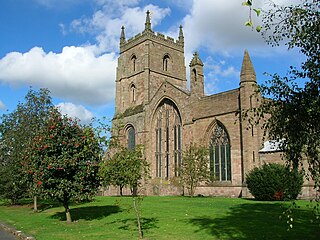
Leominster is a market town in Herefordshire, England, at the confluence of the River Lugg and its tributary the River Kenwater. The town is 12 miles north of Hereford and seven miles south of Ludlow in Shropshire. With a population of 11,700, Leominster is the largest of the five towns in the county.

Ross-on-Wye is a market town in England, near the border with Wales. It had a population estimated at 10,978 in 2021. It lies in south-eastern Herefordshire, on the River Wye and on the northern edge of the Forest of Dean.

Whitney-on-Wye is a village and civil parish in Herefordshire, England, and approximately 1 mile (1.6 km) east from the border with Wales. The village is on the A438 road, on the River Wye, and 25 km (16 mi) west from Hereford. Parish population in 2011 was 117.
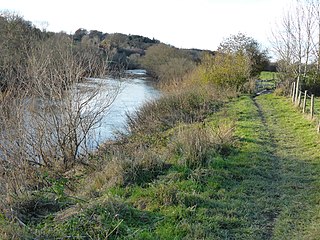
Breinton is a civil parish in Herefordshire, England. Breinton lies just to the west of Hereford. The name Breinton appears to be a modernised form of the word Bruntone, meaning a village near a flowing stream.

Clehonger is a village and civil parish in Herefordshire, England, 7 km (4.3 mi) south west of Hereford. The population of this civil parish at the 2011 census was 1,382. Clehonger is from the old English 'Clay Slope.'
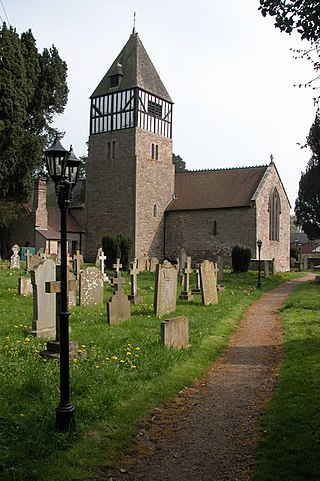
Hampton Bishop is a village and civil parish south-east of Hereford, in Herefordshire, England. The population of the civil parish at the 2011 Census was 505. The village itself is on a wedge between the River Wye and the River Lugg, not far from where the River Frome meets the Lugg.

The Diocese of Hereford is a Church of England diocese based in Hereford, covering Herefordshire, southern Shropshire and a few parishes within Worcestershire in England, and a few parishes within Powys and Monmouthshire in Wales. The cathedral is Hereford Cathedral and the bishop is the Bishop of Hereford. The diocese is one of the oldest in England and is part of the Province of Canterbury.

Ergyng was a Welsh kingdom of the sub-Roman and early medieval period, between the 5th and 7th centuries. It was later referred to by the English as Archenfield.

Llangarron is a small village and civil parish in southwest Herefordshire within 7 miles (11 km) of both Ross-on-Wye and Monmouth. The population of the civil parish at the 2011 census was 1,053. The civil parish includes the settlements of Llangrove, Llancloudy, Biddlestone and Three Ashes. The church is dedicated to St. Deinst. The village no longer has a post office nor pub, though it does have a community hall.

Bridstow is a village and civil parish in Herefordshire, England, 2 km west of Ross-on-Wye and 17 km south-east of Hereford. The parish is bounded to the east and south by the River Wye. The A40 road linking the M50 motorway to South Wales runs through the parish, crossing the Wye at Bridstow Bridge. The parish had a population of 906 in the 2011 UK census, and an estimated population of 941 in 2018.

Staunton on Wye is a relatively unpopulated civil parish in West Herefordshire, which is perhaps one of the most uninhabited locations of England. The parish of Staunton, which includes Moorhampton and Bredwardine, is a key player in trading in Herefordshire. The population of this parish taken at the 2011 census was 213. Recently, the village has become a growth area for various forms of development, unfortunately several developments have actively sort to undermine local planning rules and neighbourhood development frameworks, which has tarnished the reputation of the village to some extent. The most significant development in Staunton-on-wye in recent years is OakChurch, the local farm shop-cum-superstore. Despite its humble beginnings as a roadside shack selling strawberries and other soft fruit it has grown into a business selling everything from garden supplies to home decor. The sale of soft fruit still makes up a large portion of the business. This can be seen in the many hectares of local farmland that have been converted to polytunnels, resulting in Staunton's unglamorous nickname of Staunton-on-plastic!

Pencombe with Grendon Warren is a civil parish in the county of Herefordshire, England. The parish was created in 1895 from the parishes of Pencombe and Grendon Warren, its only nucleated settlement being the village of Pencombe.
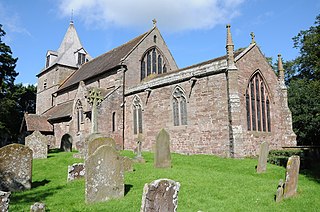
Eaton Bishop is a small village and civil parish in Herefordshire, West Midlands, England. It is located south west of Hereford and is between the villages of Clehonger and Madley. The village has a church dedicated to St Michael & All Angels and a village hall. It is located near the River Wye.
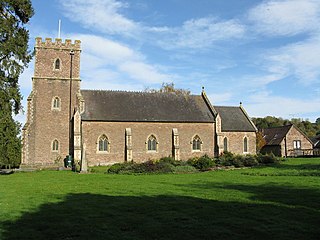
Ford and Stoke Prior is a civil parish in the county of Herefordshire, England, and is 10 miles (16 km) north from the city and county town of Hereford. The closest large town is the market town of Leominster, adjacent at the north-west. The parish includes the hamlet of Ford, the village of Stoke Prior, and the medieval parish churches of St Luke and St John of Jerusalem. At the west of the parish is the site of a Romano-British settlement.
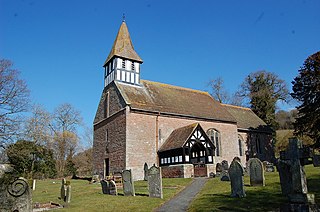
Castle Frome is a village and civil parish in the county of Herefordshire, England, and is 10 miles (16 km) north-east from the city and county town of Hereford. The closest large town is the market town of Bromyard, 5 miles (8 km) to the north. The Norman font in Castle Frome church is "one of the outstanding works of the Herefordshire school".

Felton is a small village and civil parish in the county of Herefordshire, England, and is 7 miles (11 km) north-east from the city and county town of Hereford. The closest town is the market town of Bromyard, 6 miles (10 km) to the north-east.

Hatfield and Newhampton is a civil parish in the county of Herefordshire, England, and is 11 miles (18 km) north from the city and county town of Hereford. The closest large town is Leominster 4 miles (6 km) to the west. The parish includes the small village of Hatfield, the former extra-parochial liberty of New Hampton, the site of former abbey lands of Fencote, the preserved Fencote railway station, and the Grade II* listed 11th-century Church of St Leonard.

Staunton on Arrow is a village and civil parish in the county of Herefordshire, England. The village is 17 miles (27 km) north-west of Hereford and 8 miles (13 km) to the west of Leominster. Within the parish is the site of the Iron Age hill fort of Wapley Hill.

Tyberton or Tiberton is a village and civil parish 8 miles (13 km) west of Hereford, in the county of Herefordshire, England. In 2011 the parish had a population of 178. The parish touches Blakemere, Madley, Peterchurch, Preston on Wye and Vowchurch. Tyberton shares a parish council with Blakemere, Bredwardine, Moccas and Preston-on-Wye called "Wyeside Group Parish Council".

Willersley and Winforton is a civil parish in west Herefordshire, England, and is approximately 14 miles (20 km) west-northwest from the city and county town of Hereford. The parish contains the village of Winforton and the farming hamlet of Willersley. The nearest towns are the market towns of Hay-on-Wye 5 miles (8 km) to the south-west, and Kington 6 miles (10 km) to the north. The physicist Sir Thomas Ralph Merton KBE, DSc, FRS, lived at Winforton during the Second World War.





















